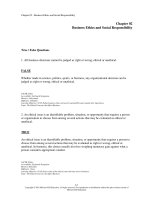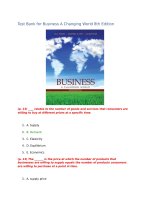Business a changing world 7e by ferrell chap005
Bạn đang xem bản rút gọn của tài liệu. Xem và tải ngay bản đầy đủ của tài liệu tại đây (3.5 MB, 48 trang )
5-1
Business in a
Changing World
Chapter 5
Options for Organizing Business
2
McGraw-Hill/Irwin
Copyright © 2009 by the McGraw-Hill Companies, Inc. All rights
5-3
Zingerman’s DeliInnovation, quality, & growth
Thanks to the Internet, haggling has never been
easier, especially in the area of online apparel
sales.
5-4
Forms of Business Ownership
•Sole proprietorship
•Partnership
•Corporation
5-5
Comparing the Forms of
Business Ownership
Source: U.S. Bureau of the Census, Statistical Abstract of the U.S. 2003,
(Washington, D.C.: U.S. Government Printing Office, 2004), p. 459.
5-6
Forms of Business Ownership
Various Forms of Business Ownership
75-7
Forms of Business Ownership
Sole Proprietorship
Businesses owned and operated by one
individual; the most common form of business
organization in the United States
5-8
Forms of Business Ownership
Sole Proprietorship
•Many restaurants
•Hair salons
•Flower shops
•Dog kennels
•Independent grocery stores
5-9
Forms of Business Ownership
Sole Proprietorship -- Facts
• 15-20 million in the U.S.
• 80% of all businesses
• Men 2x more likely than
women to start own
business
10
5-10
Forms of Business Ownership
Advantages of a Sole Proprietorship
•Ease and cost of formation
•Secrecy
•Distribution and use of profits
•Flexibility and control of the business
•Government regulation
•Taxation
5-11
Forms of Business Ownership
Disadvantages of a Sole Proprietorship
•Unlimited liability
•Limited sources of funds
•Limited skills
•Lack of continuity
•Lack of Qualified Employees
•Taxation
5-12
Forms of Business Ownership
Partnership
A form of business organization defined by the
Uniform Partnership Act as “an association of two
or more persons who carry on as co-owners of a
business for profit”
5-13
Forms of Business Ownership
Types of
Partnerships
•General partnership
•Limited partnership
5-14
Forms of Business Ownership
General partnership
A partnership that involves a complete sharing
in both the management and the liability of the
business
5-15
Forms of Business Ownership
Limited partnership
A business organization that has at least one
general partner, who assumes unlimited liability,
and at least one limited partner whose liability is
limited to his or her investment in the business.
5-16
Articles of Partnership
Legal documents that set forth the basic
agreement between partners.
5-17
Articles of Partnership
1.Name, purpose, location
2.Duration of the agreement
3.Authority and responsibility of each partner
4.Character of partners (i.e., general or limited,
active or silent)
5.Amount of contribution from each partner
6.Division of profits or losses
7.Salaries of each partner
5-18
Articles of Partnership
8.How much each partner is allowed to withdraw
9.Death of partner
10.Sale of partnership interest
11.Arbitration of disputes
12.Required and prohibited actions
13.Absence and disability
14.Restrictive covenants
15.Buying and selling agreements
5-19
Partnerships Advantages & Disadvantages
Advantages
•Ease of organization
•Capital & credit
•Knowledge & skills
•Decision making
•Regulatory controls
Disadvantages
•Unlimited liability
•Business responsibility
•Life of the partnership
•Distribution of profits
•Limited sources of
funds
•Taxation of
partnerships
5-20
Keys to Success in Business Partnerships
1.Keep profit sharing and ownership at 50-50
2.Partners should have different & complementary skill sets
3.Honest is critical
4.Maintain face-to-face communications
5.Transparency – sharing information
6.Awareness of funding constraints and limited resources
7.To be successful, you need experience
8.Family is priority; limit associated problems
9.Do not become too infatuated with “the idea” think
implementation
10.Couple optimism with realism in sales and growth
expectations
5-21
Forms of Business Ownership
Corporations
Legal entities created by the state whose assets
and liabilities are separate from its owners..
5-22
Forms of Business Ownership
Corporations
Typically owned by many individuals and/or
organizations who own shares of the business –
stock (shareholders or stockholders)
5-23
Corporations
Stock & Dividends
Stock – shares of a corporation that may be bought or
sold
Dividends – profits of a corporation that are distributed
in the form of cash payments to stockholders.
5-24
Corporations
Creating a Corporation
A Corporation is created (incorporated) under
the laws of the state in which it incorporates.
The individuals creating the corporation are
called incorporators.
5-25









